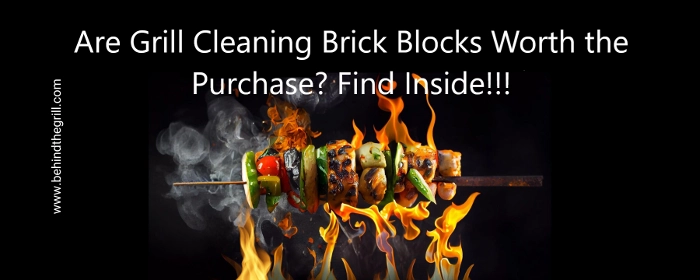What is a Grill Cleaning Brick Block and How Does It Work?

-
Ever wondered about Grill Cleaning Brick Blocks and their magic? Let's explore how they work!
- Composition of Grill Cleaning Brick Blocks
- How Does a Grill Cleaning Brick Block Work?
- Benefits of Using a Grill Cleaning Brick Block
- Proper Usage and Safety Tips
- Conclusion
Ever wondered about Grill Cleaning Brick Blocks and their magic? Let's explore how they work!
Grilling season brings joy and delicious meals, but it also means grappling with a grimy grill.
That's where a grill cleaning brick block comes into play.
These unassuming blocks might not steal the spotlight, but they're a game-changer when it comes to maintaining a sparkling clean grill.
Read Next: Can Grill Cleaner and Vinegar Duo Conquer the Toughest Grease and Grime?
Composition of Grill Cleaning Brick Blocks
At first glance, a grill cleaning brick block might resemble a standard brick, but its composition is specifically tailored for effective grill cleaning.
Made from a blend of pumice or other non-toxic materials, these blocks boast a unique porous and abrasive structure.
How Does a Grill Cleaning Brick Block Work?
The magic of these blocks lies in their abrasive texture.
When rubbed against a heated grill, the brick's surface grates away stubborn grease, grime, and food residue.
Think of it as a gentle exfoliation for your grill, lifting away the toughest of stains without leaving behind any harmful chemicals or residues.
Benefits of Using a Grill Cleaning Brick Block
Using a grill cleaning brick block offers numerous advantages.
Firstly, it's a non-toxic cleaning method, ensuring that your food stays free from any harmful chemical remnants.
Additionally, these blocks effectively eliminate grease and grime, leaving your grill in top-notch condition.
They're also durable and reusable, providing long-term value for your grill maintenance routine.
Proper Usage and Safety Tips
When using a grill cleaning brick block, it's crucial to prioritize safety.
The block's design, lacking a handle, means you'll grip it close to the hot grates, increasing the risk of burns.
Always wear heat-resistant gloves while cleaning to shield your hands from potential heat exposure.
Moreover, the absence of a handle might make it challenging to maneuver the block, and there's a possibility of accidentally touching the hot grill surface.
This design aspect could be seen as a disadvantage, particularly for users concerned about safety and ease of use.
An alternative that's both environmentally friendly and safer for users is a wood grill scraper.
Crafted from sturdy wood, these scrapers feature an ergonomic handle, keeping your hands at a safe distance from the heat.
Additionally, the wooden material is less prone to transferring heat, reducing the risk of burns while effectively cleaning the grill grates.
The wooden scraper not only offers a safer cleaning experience but is also a sustainable choice, being biodegradable and minimizing environmental impact compared to some other cleaning tools.
Always prioritize safety and comfort when choosing a cleaning tool for your grill, considering both effectiveness and the well-being of yourself and your grill.
Check out our wooden grill scraper on Amazon USA
Check out our wooden grill scraper on Amazon Canada
Conclusion
A grill cleaning brick block might seem like a humble tool, but its impact on grill maintenance is profound.
Regular use of these blocks ensures a clean, hygienic grilling surface, enhancing both the taste of your meals and the lifespan of your grill.
We hope you liked today's read. Until next time, and forever.
Happy grilling! :)
-
Ever wondered about Grill Cleaning Brick Blocks and their magic? Let's explore how they work!
- Composition of Grill Cleaning Brick Blocks
- How Does a Grill Cleaning Brick Block Work?
- Benefits of Using a Grill Cleaning Brick Block
- Proper Usage and Safety Tips
- Conclusion